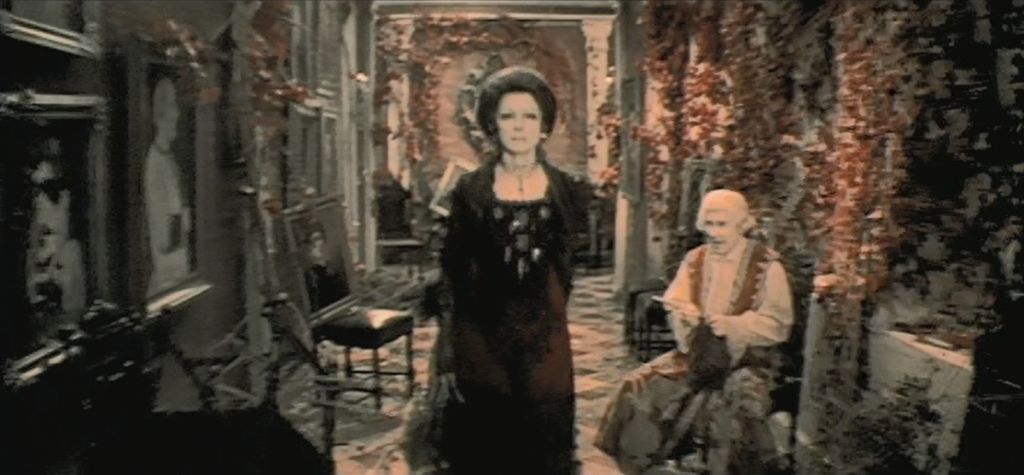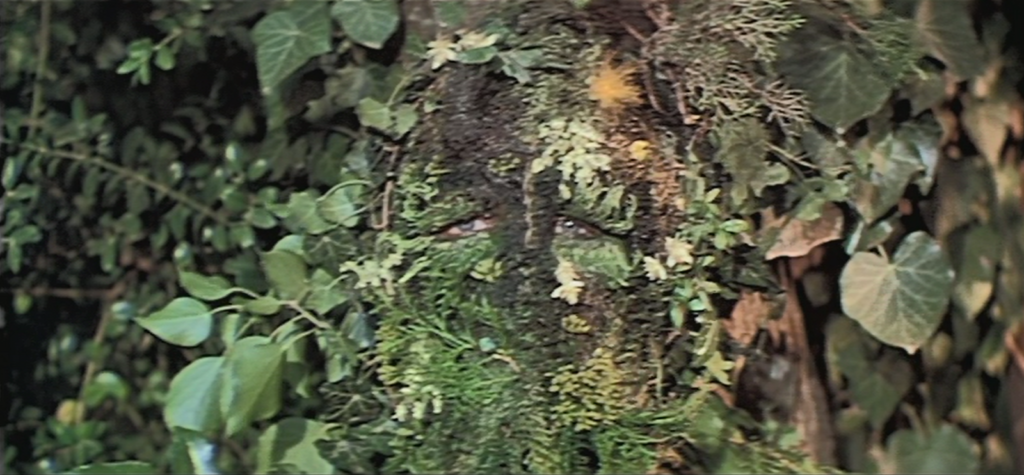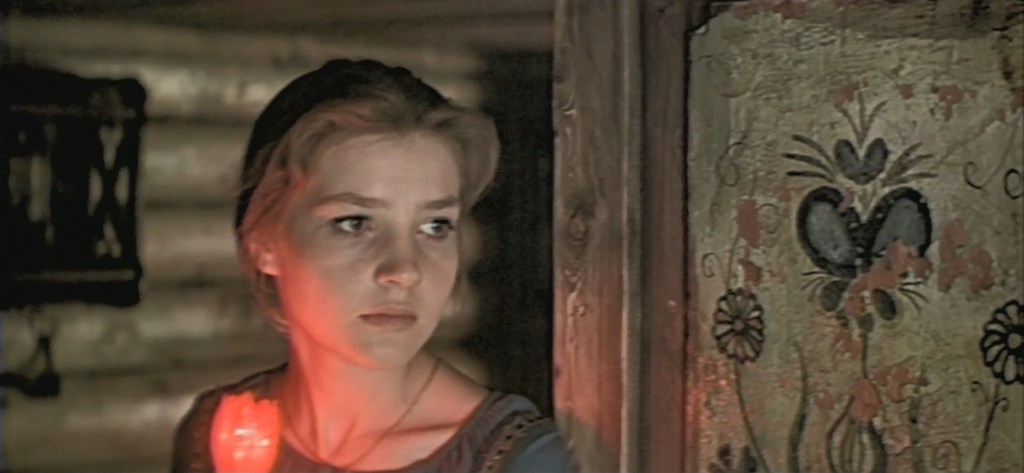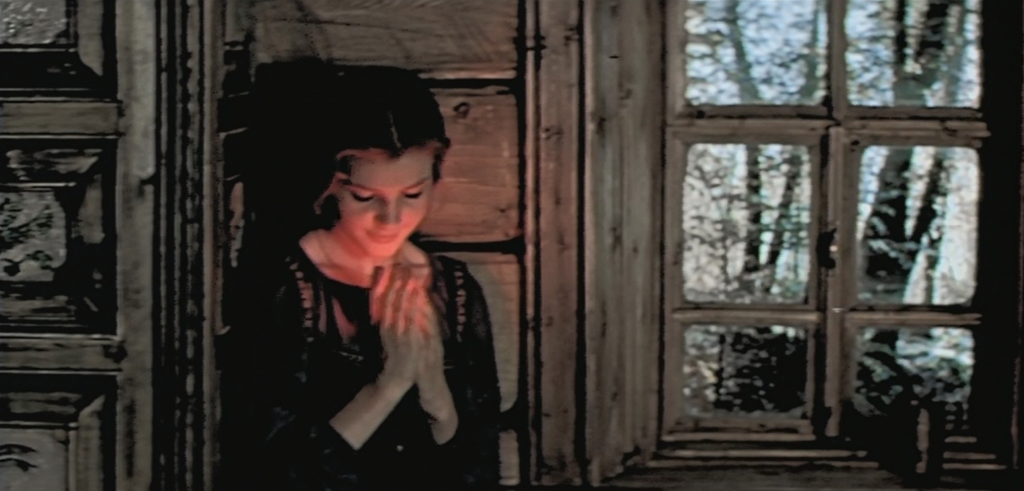
No one will argue that the two finest cinematic adaptations of the Beauty and the Beast story are by Jean Cocteau and the Walt Disney Company, respectively. But dig deeper into fairy tale cinema and you’ll uncover the hypnotic, oneiric The Scarlet Flower (1977), adapted loosely from the 19th century author Sergey Aksakov. In the opening minutes, a peacock strides through the hall of a mansion gone literally to seed, red blossoms oozing out of a monochrome corridor, and a ghostly, grinning woman steps out of her painted image hanging on a wall. Far away, in a country cottage, a bird alights on the head of an indifferent cat, and a rooster occupies a doghouse while its ousted occupant paces outside – omens which disturb the merchant Yerofei Yerofeich (Lev Durov) before he sets out on his horse-drawn cart into the woods. Director Irina Povolotskaya eschews the broad pantomime stylings of other Soviet fairy tale films, such as those of genre specialist Aleksandr Rou (Father Frost); instead, she creates an atmosphere of psychic unease, relying upon a score of bells, harpsichord, and Russian folk songs mournful or feverishly frenetic. It’s also infused by an almost pagan eroticism: her Beast is not leonine, but a creature of the forest, the former prince now hidden inside a cloak of twigs, leaves, and moss like one of Tolkien’s Ents. Even our introduction to the merchant’s teenage daughter Alyona (Marina Ilyichyova) has the feel of a dark sexual confession: she asks her father to retrieve the scarlet flower she’s seen only in her dreams, but asks that he tell no one about it. Later, after he’s discovered the flower and brought it home, she huddles in a corner away from family and friends, cupping the prize in her hands as it glows with red warmth. Sometimes that magic red lights up the outdoors, shining through the windows, tracing a portal between the mundane world and the cursed realm of the Beast. Scenes set within the Beast’s haunted palace, perched at the edge of a lake, are drained of color by cinematographer Aleksandr Antipenko, allowing only oranges and reds while the inhabitants are bloodless, bluish gray – surreal images that call to mind Wojciech Has’s The Hourglass Sanatorium (1973) in their occult mystery. This is ostensibly a children’s film, but the embattled director Povolotskaya is obsessively drawn into details that enrich the film and make it something much more. As she states in an interview on the 2003 Ruscico DVD, her vision was questioned relentlessly by the studio heads, and the film was cut by “500 meters” – the end result is only an hour long. But what an hour!
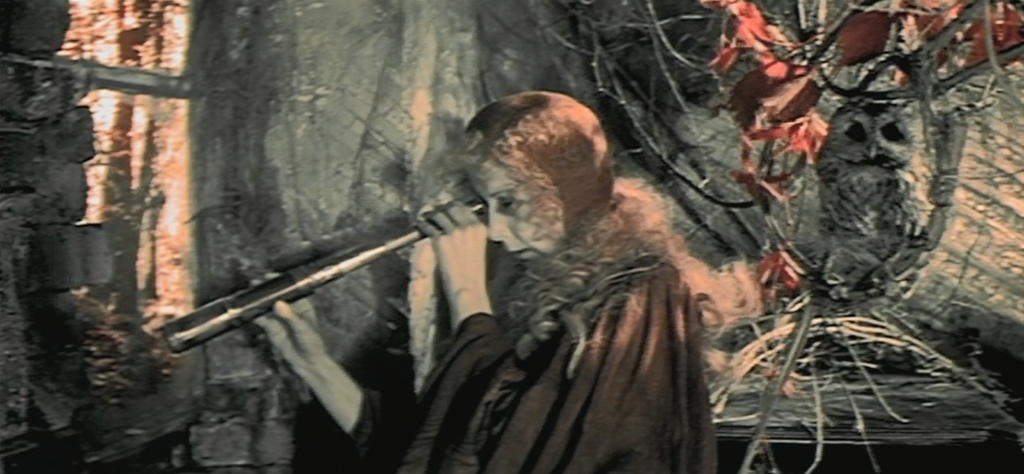
The fairy (Alla Demidova) spies on her visitor Alyona.
Povolotskaya and screenwriter Natalya Ryazantseva supplement Aksakov’s tale with a fairy, occasionally called a witch in the dialogue, and indeed gradually transforming through the story from a powder-wigged phantom in baroque dress into something closer visually to Baba Yaga, a reflection of the desolation she feels: we learn that she’s cursed the prince out of her own anxieties. (A recurring theme in the film seems to be a fear of being laughed at, from the Beast to the fairy; even Alyona’s own sisters can’t stop laughing. Perhaps this story is conceived by Alyona herself, acting out her insecurities in an extended diary entry.) Her hobbies include harpsichord playing and divination; she tells Alyona, “I can give you a book with cabalistic signs, or I can teach you fortune telling, or I can show you a lucky star that will always direct you. But you must run away from here. Tell me, what do you need [Beast] for?” The decision to include this new character also shifts the role of antagonist away from the Beast, and despite some eerie, dislocated threats (we only see his eyes) toward Alyona’s trespassing father early on, his character softens quickly as he and Alyona have romantic assignations in green fields, beside waterfalls, and on the murky lake – out of which the Swamp Thing-like creature rises to romantically join Alyona in her drifting boat. Yet the fairy is hardly a typical villain, and retains her own eccentricities, such as keeping a domesticated peacock and turtle, the latter wandering across her parlor table as she pets it. The peacock becomes an unusual recurring image: when Alyona first parts the Beast’s veil to match his gaze unobstructed, she recoils from what’s still obscured from us: in a manic edit Povolotskaya instead shows us the peacock swiveling to display the eyes of its feathers.
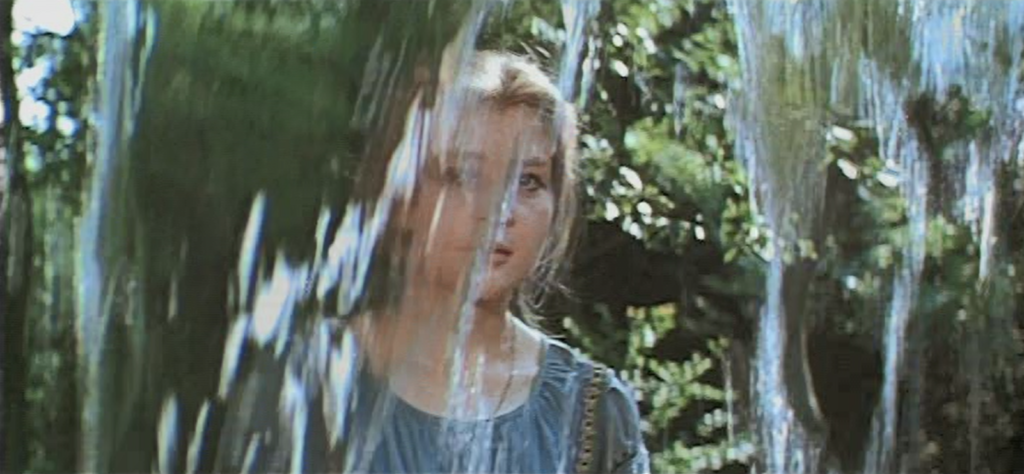
Alyona (Marina Ilyichyova) gazes at the Beast through a watery lens.
The dreamlike quality to the film also borders frequently on nightmare. As characters recall – or are visited by – the scarlet flower, it flashes as a red beacon on the screen, illuminating the world with an almost apocalyptic light (with shades of Close Encounters of the Third Kind when it beams through the windows). The rustic villagers at one point fill the merchant’s home, swaying slowly back and forth while they sing their folk song like something out of a Bela Tarr film (or perhaps George Romero). And the film features an actual nightmare of the Lynchian variety, filmed in broad daylight, as Alyona’s siblings discover the Beast hiding inside the merchant’s cart with all the impact of a dark sexual secret being dragged traumatically into the public eye. After an accidentally extended separation from the Beast, in which he’s convinced Alyona has abandoned him, she returns to the tree at the foot of which the scarlet flower grows to find that her lover has partially decomposed into moss and soil. She wraps her body over the golem-like shape, lifting the curse – and color finally fills the palace and returns to the complexion of the fairy and the only other occupant of the haunted house, her companion referred to in the credits as the Old Man (Aleksey Chernov). The Beast is restored to his more conventionally handsome shape as the prince – also changing actors according to Povolotskaya, metamorphosing from a makeup-laden Valentin Gneushev (who would later gain fame in Russia as an influential circus director) into Aleksandr Abdulov. But I prefer the ballrooms with the M.C. Escher patterns on the floor, the wandering turtle and peacock and particularly placed owl, the relics and ghosts of the desaturated, haunted world before the spell was broken.
